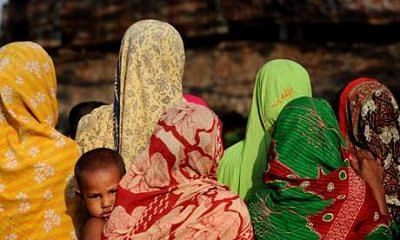The nexus: Undocumented migration and violence against women

Photo: Munir Uz Zaman/ AFP
The boom in the working age population in Bangladesh struggling with poor employment generation in the occupations and industries of the formal economy and under-employment in the informal economy has created an environment where labour force participation is largely poverty-driven.
According to the Bangladesh Bureau of Statistics (BBS), the unemployment rate among women is nearly double that of the rate for men, the labour force participation rate of women is about one-third of men, and the formal sector employment is only about half of men. Women are largely concentrated in the invisible informal economy with disproportionate presence in the low-productivity agricultural and low-wage domestic work and unpaid family labour work. Abject poverty, therefore, has a female face in Bangladesh. The situation has weakened the bargaining capacity of the workers at large and opened the door for women workers' exploitation in the domestic economy and trafficking into the economies of the sub-continent, the Middle-East, East Asia and other countries of the world.
The invisibility of women workers gives an impression that women are not economically active and, therefore, they are less capable than men to participate in economic decision-making. This impression leads to exclusion of women from a decision on their migration as well as from the process leading to migration.
The invisibility also creates an artificial sense of women's fragility and presents them as dependents, who would not make a decision to migrate if they have a choice, and who are in need of overt protection. This false sense leads to women's exclusion from the discussions on safe migration, creating a high level of lack of information about legitimate official channels among women. It paves the way for an imposition of excessively restrictive regime which makes documented migration harder for women.
The combined effect of all these is that a right to movement is not seen as one of the fundamental rights of women. Women with an intention to migrate for making a better life for themselves and their families are looked down upon. They do not have platforms where they can openly present the difficulties they encounter with an expectation that they would find support and solutions without being further victimised or controlled.
The resultant scenario is one where migration through family referral or on pretext of marriage becomes a quicker method to convince women to migrate and ends up making women easy prey to informal and often illegal channels to obtain regular labour.
A woman who undertakes international migration through undocumented process or irregular channels or as a trafficked person is not only far more vulnerable to abuse, sexual exploitation and labour slavery than men and women who migrate through legitimate official channels but is also seen as a criminal by the authorities in the destination country of. The branding as a criminal restricts the avenues of legal and safe return. She is also far less likely to be accepted if she were to return to her family.
The solution lies in recognising women as an economic actor, capable of deciding on alternatives for livelihoods and with a right to movement. It is important that legitimate migration is made easily and openly accessible to them. Migrant Bangladeshi women workers have contributed enormously to the economies of the countries of the sub-continent. It is essential that this contribution is recognised and negative perceptions about the migrant workers addressed in the destination countries.
Since international movement of workers often involves two or more countries, it is important that safe migration-based approach to trafficking is pursued and the solutions are sought through:
* Regional cooperation to formulate and implement safe migration procedures as well as to address the situation where India and Pakistan have become transit countries for wider international trafficking for not only women and girls from these countries but also for those from Bangladesh and Nepal;
* Gender equitable policies on migration and migrant workers' employment, which are consistent with the ILO Multilateral Framework on Labour Migration, and which provide non-binding principles and guidelines for a rights-based approach to labour migration;
* Open availability of work opportunities in various countries respectful of international labour standards, especially, migrant workers right to a written contract, fair wage, safe working conditions and protection from sexual violence at workplace, and other rights as enshrined in international instruments such as the ILO Convention 189 and Recommendation 201 on the Decent Work for Domestic workers;
* Joint mechanisms for the monitoring of recruitment processes and commonly agreed standards for the regulation of the recruitment agencies.
In addition to the above, it is of utmost importance that the formulation and implementation of robust social protection in Bangladesh is pursued to support women in their social role as well as when they are faced with difficulty in the process of or during migration and upon their return.

 For all latest news, follow The Daily Star's Google News channel.
For all latest news, follow The Daily Star's Google News channel. 



Comments